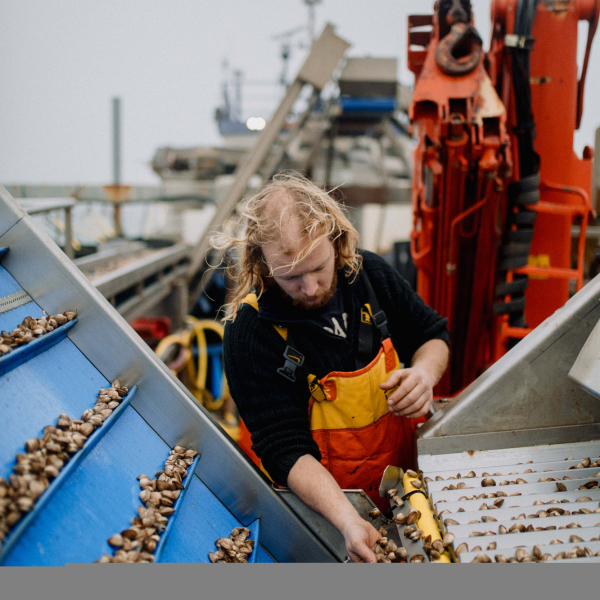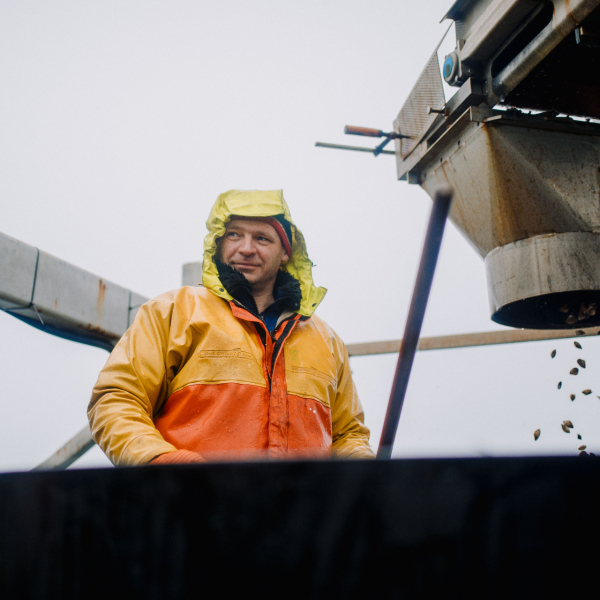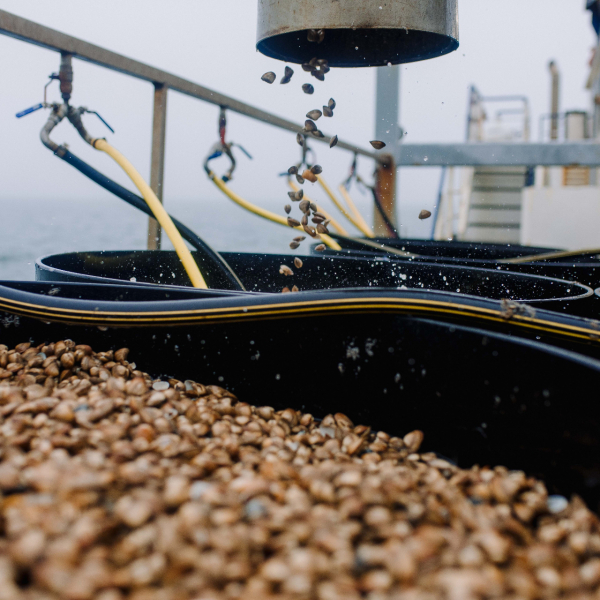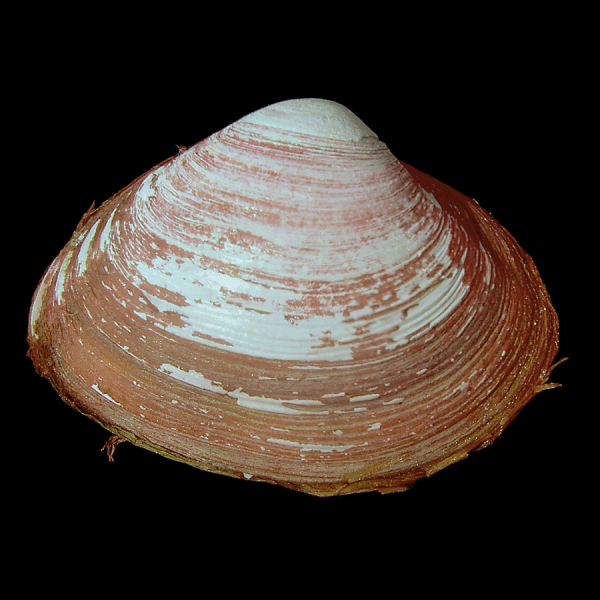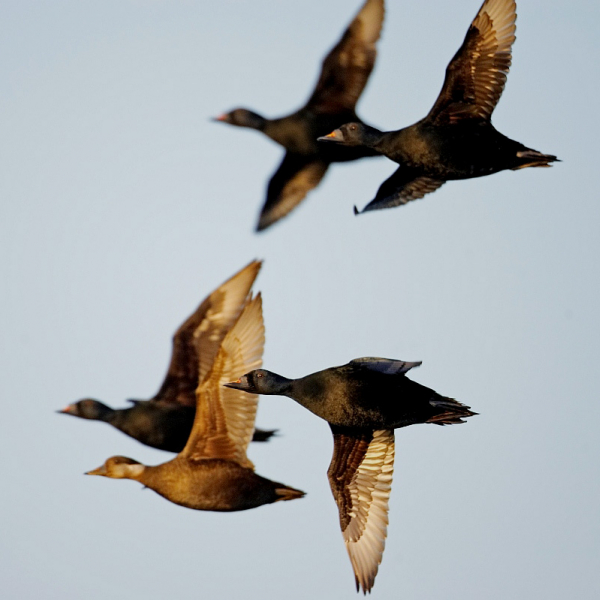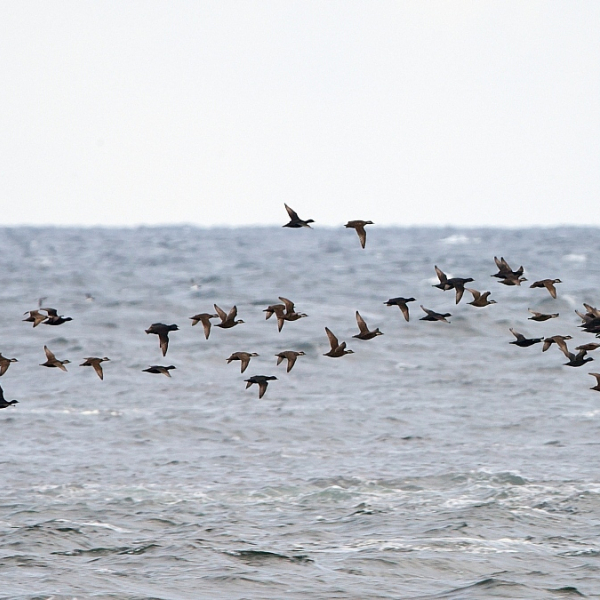Research into a sustainable fishing method for cut through shell
~~ for Dutch scroll down ~~
The cut through shell (Spisula subtruncata) is found in large numbers in the Dutch sector of the North Sea: researchers from Wageningen Marine Research estimate the total at around one billion kilograms. The 13.7 million kilograms (1.37%) of cut through shells that Dutch fishermen have been catching for a number of years is mainly intended for export. In itself, the sale of these shellfish on the Dutch market would be a sustainable alternative for some of the millions of kilos of seafood that our country imports annually, sometimes from tens of thousands of kilometres away.
Marine researcher Katja Philippart from the Royal Netherlands Institute for Sea Research (NIOZ) is leading a project to find out whether more fishing of the cut through shell can be balanced with the presence of the common scoter (Melanitta nigra), a protected seabird. "Ecologically speaking, shellfish are a sustainable source of protein: they are low down in the food chain. In addition, there is a short chain from catch to plate and therefore little environmental impact." Nevertheless, it is essential to investigate whether a possible increase in the catch is possible and desirable within the legislation on the protection of nature. Philippart: "Every year from November to March, common scoters who spend the winter in the North Sea depend on the cut through shells as a food source."
Back from a 20-year absence
Until the 1990s, cut through shells were present in large quantities in the coastal waters of the North Sea and was fished at the time. That is, until the stock of cut through shell in Dutch waters rapidly declined due to a lack of population growth. As a result, the common scoter disappeared and eventually the fishing stopped as well. Since a few years, the population of cut through shell has increased substantially again.
Room for birds and fishermen
In 2017, the Rijksdienst voor Ondernemend Nederland (RVO) provided financial support to a consortium to investigate whether a professional fishery for semi-knot shells is possible without harming the common scoter. The challenge of the RVO project, entitled Room for birds and fishermen, lies partly in finding common interests among the partners: in addition to NIOZ and Wageningen Marine Research, these include the Dutch Fishermen's Union and the Netherlands Society for the Protection of Birds. Philippart: "It is precisely by working together - for the first time in Dutch history - that fishermen, researchers and nature conservationists can inform each other of their wishes and try to find solutions together."
Fifth sampling
At the beginning of May, NIOZ sampled the seabed north of Ameland for the presence of the cut through shell. Philippart: "This was the fifth and for the time being final sampling. Now we can compare the data from successive years. After further analysis of the data this summer, we hope to be able to establish whether it is possible to catch the shellfish in the North Sea in a sustainable way."
Onderzoek naar duurzame vangst halfgeknotte strandschelp
In een uniek samenwerkingsverband verkennen NIOZ en Wageningen Marine Research samen met beroepsvissers en natuurbeschermers wat een duurzame vangst van de halfgeknotte strandschelp in de Noordzee is zonder dat de beschermde zwarte zee-eend daar last van heeft. Op basis van de resultaten zal het consortium eind dit jaar een advies uitbrengen aan het ministerie van LNV.
De halfgeknotte strandschelp (Spisula subtruncata) komt in het Nederlandse deel van de Noordzee in groten getale voor: onderzoekers van Wageningen Marine Research schatten het totaal op ongeveer een miljard kilogram. De 13,7 miljoen kilogram (1,37%) halfgeknotte strandschelp die sinds enkele jaren door Nederlandse vissers wordt gevangen, is voornamelijk bestemd voor de export. Op zichzelf zou de afzet van deze schelpdieren op de Nederlandse markt een duurzaam alternatief zijn voor een deel van de miljoenen kilo’s zeevruchten die ons land jaarlijks importeert van soms tienduizenden kilometers ver.
Zeeonderzoeker Katja Philippart van het Koninklijk Nederlands Instituut voor Onderzoek der Zee (NIOZ) leidt een project dat uitzoekt of meer vangst van de halfgeknotte strandschelp samen kan gaan met de aanwezigheid van de zwarte zee-eend (Melanitta nigra), een beschermde zeevogel. “Ecologisch gezien vormen schelpdieren een duurzame eiwitbron: ze zitten laag in de voedselketen. Daarnaast is er een korte keten van vangst naar bord en dus weinig milieubelasting.” Toch is het essentieel om te onderzoeken of een eventuele intensivering van de vangst binnen de natuurwetgeving wel mogelijk en gewenst is. Philippart: “Ieder jaar van november tot en met maart zijn zwarte zee-eenden die op de Noordzee overwinteren afhankelijk van de halfgeknotte strandschelp als voedselbron.”
Terug van 20 jaar ‘weggeweest’
Ook tot de jaren ’90 was de halfgeknotte strandschelp in grote hoeveelheid in de kustwateren van de Noordzee aanwezig en in die tijd werd er ook al op het schelpdier gevist. Totdat het bestand aan halfgeknotte strandschelpen in de Nederlandse wateren in korte tijd afnam door het uitblijven van aanwas. Het gevolg was dat de zwarte zee-eend verdween en uiteindelijk werd ook de visserij gestaakt. Sinds enkele jaren is de populatie halfgeknotte strandschelpen weer flink toegenomen.
Ruimte voor vogels en vissers
In 2017 gaf de Rijksdienst voor Ondernemend Nederland (RVO) een consortium financiële steun om te onderzoeken of een beroepsmatige visserij op halfgeknotte strandschelpen mogelijk is zonder dat de zwarte zee-eend er schade van ondervindt. De uitdaging van het RVO-project, met de titel Ruimte voor vogels en vissers, ligt deels in het vinden van gezamenlijke belangen door de partners: naast van het NIOZ en Wageningen Marine Research zijn dat de Nederlandse Vissersbond en de Vogelbescherming Nederland. Philippart: “Juist door – voor het eerst in de Nederlandse geschiedenis – samen te werken, kunnen de vissers, onderzoekers en natuurbeschermers elkaar van hun wensen op de hoogte brengen en proberen samen tot oplossingen te komen.”
Vijfde bemonstering
Begin mei bemonsterde NIOZ ten noorden van Ameland de zeebodem op de aanwezigheid van de halfgeknotte strandschelp. Philippart: “Dit was de vijfde en voorlopig laatste bemonstering. Nu kunnen we de gegevens van opeenvolgende jaren gaan vergelijken. Na verdere analyse deze zomer van de gegevens hopen we te kunnen vaststellen of de vangst van het schelpdier in de Noordzee op een duurzame manier mogelijk is.”
Website
To keep the public informed about the project Room for birds and fishermen, a beautiful website has been launched (in Dutch).
Om het publiek op de hoogte te houden van het project Ruimte voor vogels en vissers, is een prachtige website gelanceerd.
